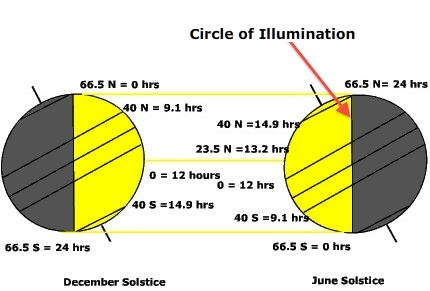Day length and seasonsDay length is determined by the length of time the Sun is above the horizon. Day length changes through the year as the orientation of the Earth to the Sun changes. The circle of illumination is the imaginary circle that separate day from night.
Figure 2.14 Variations in day length. Figure 2.14 shows two extreme cases, the December and June solstices. Note during December that more of a given latitude in the Southern hemisphere is exposed to the Sun. This is the longest day of the year for those living poleward of the Equator. In June the opposite occurs with longer day length in the Northern hemisphere. Note that in both cases, the circle of illumination bisects the Equator (cuts it in half). The Equator is the only place on Earth that experiences equal day length every day of the year. The Earth's axis is neither inclined toward or away from the Sun on the equinoxes and so the circle of illumination cuts all latitudes in half resulting in equal day length for the entire Earth. To summarize the changing seasonal conditions: Table 2.1 Earth- Sun Relations and Season
|
